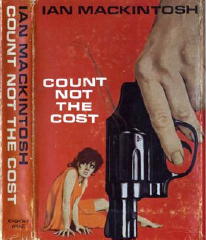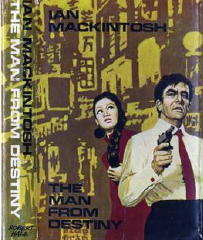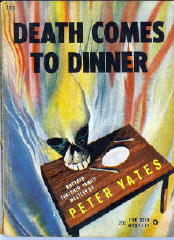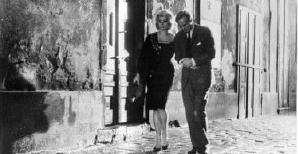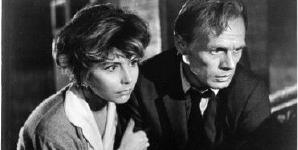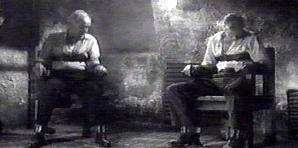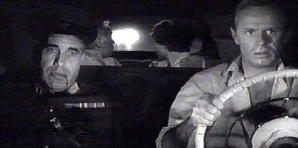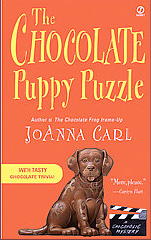July 2008
Monthly Archive
Tue 29 Jul 2008
I’ll be leaving tomorrow morning for my yearly trek to Dayton and this year’s Pulpcon. I’m going to do my best to stay away from computers and email while I’m gone, so if I don’t see you there — and some of you I know I will — so long until about this time next week.
In the meantime, of interest to some, perhaps, is that the Site Meter count for visitors to this blog is currently at 99,201. Or in other words, some time while I’m gone, the 100,000th person will stop by. I’m sorry I won’t be here when that happens, otherwise there’d be a door prize — flowers, a box of candy, a free subscription, or something.
If it happens to be you, give yourself a hearty handshake. Congratulations!
Sun 27 Jul 2008
THE LONE WOLF RETURNS. Columbia, 1935. Melvyn Douglas, Gail Patrick, Tala Birell, Henry Mollison, Thurston Hall, Raymond Walburn, Douglass Dumbrille. Based on the novel by Louis Joseph Vance (Dutton, 1923). Directed by Roy William Neill.
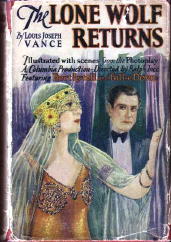
I included some background on “The Lone Wolf” as a character in this earlier post, so I won’t repeat it here. Suffice it to say that I’ve watched the two movies in the wrong order, since The Lone Wolf in Paris, the previously reviewed film, came out three years later, and starred Francis Lederer, not Melvyn Douglas, as Michael Lanyard, the notorious jewel thief.
Not that there’s any sense of continuity between the two films, as enjoyable as each of them happens to be. I don’t imagine it will spoil anything to say that at the end of The Lone Wolf Returns wedding bells seem to be in the offing, while I don’t remember anything of the sort being referred to in The Lone Wolf in Paris.
As it happens, I think that Melvyn Douglas was perfect for the part: suave, debonair, and just the kind of man who would rob wall safes in a top hat and tails. He’s in New York City in this one, or Michael Lanyard is, and not his usual European stomping ground
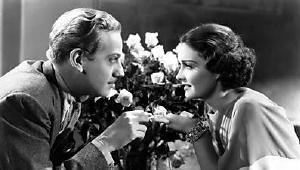
And when he meets beautiful society girl Marcia Stewart, played by beautiful Gail Patrick, he decides at once that that’s it, his days of criminal activity are over, much to the consternation of Jenkins, his devoted valet and primary assistant in thievery, played to great comedic effect by Raymond Walburn.
Gail Patrick, by the way, dropped out of movie roles in the late 1940s, only to become the executive producer for (I think) the entire run of the Raymond Burr “Perry Mason” television series in the mid-1950s.
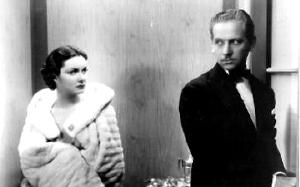
Getting back to the Lone Wolf, though, another gang of jewel robbers is not pleased to see Lanyard anywhere in the vicinity of their next job – and you get only one guess as to whose emeralds they plan to steal – and implicating him for the theft fits very nicely into their plans.
If you can ignore the funny stuff – other than the top man in command, most cops that you find in 1930s mystery movies are funny, and so are the underling henchmen, always – I think you will find this movie as entertaining as I did. (And even some of the funny stuff is funny.)
There was an earlier version of the movie, a 1926 silent film also based on the book by Louis Joseph Vance, and starring Bert Lytell and Billie Dove in the two leading roles. You can make out their likenesses on the cover of the book shown above, a Grosset & Dunlap photoplay edition.
Sun 27 Jul 2008
IAN MACKINTOSH – A Drug Called Power.
Robert Hale; UK, hardcover, 1968.
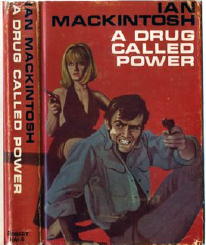
Author and TV writer-producer Ian Mackintosh has come up three time already on this blog. The first instance was in a posting of some addenda to the Revised Crime Fiction IV, in which some biographical data was given for the author, and adding the setting of a novelization he did of the British TV show The Sandbaggers.
This was followed by an email posting from Tise Vahimagi that included some data about some of the other TV shows Mackintosh was involved with. A few days later a post from British mystery bookseller Jamie Sturgeon appeared; in this the spelling of the author’s last name was discussed and possibly even settled.
I don’t have the autographed copy of A Drug Called Power that was illustrated in that latter post. What I have is a much less valuable one formerly belonging to a library somewhere in the UK. (Well, to be precise, it’s the City of London Police Library, whatever that might mean.)
And I wish I could recommend it to you, but I can’t. Not at least without a whole lot of reservations, that is, and eventually I will tell you about some of them. It’s the second in a series of three high-intensity action thrillers involving Tim Blackgrove, apparently a private eye in the first of his adventures (see below), but that seems to have had a bad ending (involving a woman he loved), and he’s turned into anti-narcotics vigilante by the time the second one has begun.
The books: [Data taken from the Revised Crime Fiction IV, by Allen J. Hubin.]
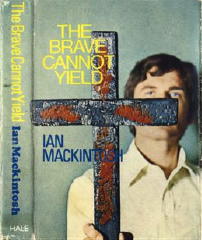
BLACKGROVE, TIM
A Slaying in September (n.) Hale 1967 [Antwerp, Belgium]
A Drug Called Power (n.) Hale 1968 [with Sue Dell; Scotland]
The Brave Cannot Yield (n.) Hale 1970 [with Sue Dell; Scotland]
Let me explain about Sue Dell, if I may (and if I can). As I said above, Blackgrove is a single-minded and totally ruthless vigilante of the Donald Pendleton–Marc “The Executioner” Bolan type, about 30, and in the prologue he meets a 19-year-old girl, Sue Dell, whom he makes his partner. Their relationship is chaste, for all I could tell, but (and I’ll get back to this) extremely violent (not toward each other, I hasten to add).
As partners in their two-person anti-crime squad, they are extremely successful, calling themselves the Trans-World Independent Narcotics Squad (T.W.I.N.S.). Maybe that tells you something about the general level the book’s written on already.
Although things are cheerfully working out very well on their own, when MI5 comes calling, they accept the employment, the challenge, and the change to save not only England but the world from a new Mastermind of Crime, complete with deadly poisons with which to blackmail the capitals of Europe into submission, one by one.
That’s about all of the plot I need to tell you, I suppose, and the story is told in a Gosh Wow (i.e., semi-corny) sort of way that television shows used be conducted back in the 1960s and 70, except for one thing: the level of violence, and the lack of compunction in killing and maiming for life, left and right. This is both the Good Guys and the Bad Guys, mind you, including the 19-year-old, five foot two and beautiful Sue Dell.
Take for example, the events at and around page 100, and judge for yourself. The wife of an opposing drug dealer is dowsed with oil, set on fire with a flame-thrower, and they watch as her body curls up in a blackened crisp. The drug dealer himself? Dumped into a vat of acid, with his head propped up to made sure it stays above the …
Forget it. That’s enough, even though the book does improve from here on in. (I skimmed a lot, just so that I could tell you this, assuming that like me, you’d want to know.) What I don’t know is what kind of person this book was written for, but it isn’t me, nor was it ever.
Nor is there any warning on the jacket about the sadistic sort of violence-oriented pornography that awaits the unwary reader inside. When you buy an Executioner novel, for example, you know exactly what you’re paying for.
So be forewarned, that’s all I say. After an investment of 100 pages, there was enough of interest for me to finish A Drug Called Power, albeit very quickly, and the two starring characters were intriguing enough that reading the next one in the series is not entirely out of the question, just to see what happens to them, should one turn up. Don’t take even this small glimmer of positivity as a recommendation, though. I’d rather not take the responsibility.
>>>
Other crime fiction by IAN MACKINTOSH, excluding the TV tie-in’s covered in earlier posts:
Count Not the Cost (n.) Hale 1968 [England; Hong Kong]
The Man from Destiny (n.) Hale 1969 [Hong Kong]
PS. Thanks to Jamie Sturgeon for providing the cover images.
[UPDATE] 02-24-09. One last cover image, this one sent me once again by Jamie Sturgeon. Other than the TV novelizations, this constitutes a complete cover gallery of Ian Mackintosh’s crime novels, five in all.
Sun 27 Jul 2008
REX STOUT – The League of Frightened Men.
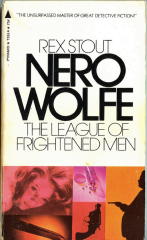
Pyramid, paperback reprint; 1st printing, Oct 1963 [Green Door Mystery]; 5th printing, Jan 1972 (shown). Serialized in The Saturday Evening Post, June 15 to July 20, 1935, as “The Frightened Men.” Hardcover first edition: Farrar & Rinehart, 1935. Cassell, UK, hardcover, 1935. Other paperback reprints include: Avon, 1942; Jonathan Press Mystery #J-33, n.d., digest, abridged; Mercury Mystery #48,n.d., digest, abridged; Jove, June 1979; Bantam, January 1995; Bantam (with Fer-de-Lance), 2008, trade ppbk.
While I can’t tell you either the day or the month, I can tell you exactly what year it was that I read The League of Frightened Men the first time. It was 1955. The reason I can be so sure about this is because I’d just joined the Dollar Mystery Guild, and one of the first selections they sent me was Full House, an omnibus volume containing two Nero Wolfe novels and a collection of short stories, and it was absolutely marvelous.
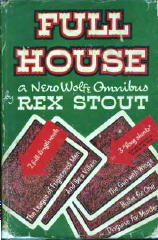
The other novel was And Be a Villain (1948) and the collection was Curtains for Three (1951) — I know because I just looked it up, as otherwise details like these I hadn’t remembered. While I can’t tell you how long it took me, what I do recall is reading the book through from cover to cover. It was as if a new world of detective fiction had opened up to me. (I still have the book today.)
It was the first time, perhaps, that I’d found the characters in a detective novel to be actual people, including the detectives, especially in contrast to the more one-dimensional ones found in, say, the Perry Mason novels, as perfect as puzzle mysteries his books were to me back in 1955.
Not that at the age of thirteen I really knew this was what it was that was different about the Nero Wolfe stories. At that age I’d barely begun to realize that a reader was allowed to have critical opinions about the books they read or the TV shows they saw.
Time passes. This past week it was that I read The League of Frightened Men for the second time, and while I did not remember first of all, who did it, some of the major plot points did come back to me. The byplay between Nero Wolfe and Archie Goodwin, his assistant and number one leg man, came back of course, as that is the probably the number one reason that the Nero Wolfe novels are still read today.
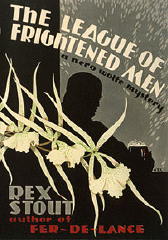
But the villain of the piece, Paul Chapin, the crippled genius the League is so frightened of, he was scary then, and he was still scary to me today. Permanently disabled because of an undergraduate Harvard prank, he’s the center of attention any time he’s on stage (so to speak), and it is no wonder when members of the so-called League of Atonement begin to die or disappear under suspicious circumstances, it is assumed at once that Chapin is responsible, and they call on Wolfe for help.
The verses the members have received do not help. Here’s the first verse of the first one, sometime else that came back to me right away, after a gap of over 50 years from the first time I read it:
Ye should have killed me, watched the last mean sigh
Sneak through my nostril like a fugitive slave
Slinking through bondage.
Ye should have killed me.
Ye killed the man,
Ye should have killed me!
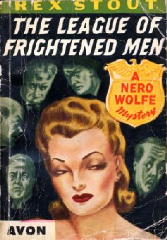
Powerful stuff, as I say, then and now. Maybe overly melodramatic? You might say so, but I’d beg to differ. It’s perfect for the novel and the resulting case for Wolfe and Archie, and perfect for me.
The League of Frightened Men (1935) was the second of the Nero Wolfe novels. The first was Fer-de-Lance (1934) — the final one being Family Affair in 1975 — and not all of the characterizations were set in stone at this early date, although many of Wolfe’s many eccentricities had already been established: his rigid schedule, his aversion to leaving his home for the outside world (although he does in League and more often, I suspect, than his reputation would suggest), the orchid room upstairs, and so on.
I am not sure how someone born after 1975, that being the date of his last appearance, would react to Nero Wolfe if he or she would happen to read one of his detective stories today, especially an early one like League.
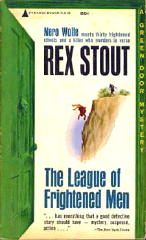
I called Rex Stout’s characters “actual people” a while ago, and while he’s an exaggeration, no doubt, I have no problem envisioning someone like Wolfe living the way he does and acting the way he does.
His adventures certainly wouldn’t have been as successful, though, without Archie to bring him back down to earth when the story needs it, and Archie, while he’s more than sharp enough in many ways, I just can’t picture him being given center stage and a case to solve on his own.
League is a long book, perhaps a little too long, and the pace sags noticeably in the middle. Wolfe often knows things that neither the reader nor Archie does not, or at least not right away. In 1955 I thought this was a wonderful book, but I can see now why it may not be one for the novice Rex Stout reader to start off with.
On the other hand, why not? The water’s fine, the images are sharp, the people detailed, and with the few caveats I’ve just stated, it’s still a terrific job of storytelling.
Fri 25 Jul 2008
S. F. X. DEAN – Such Pretty Toys.
Tor, paperback reprint; 1st printing, Oct 1986. Hardcover edition: Walker. 1982. Trade paperback: Felony & Mayhem, 2007 (shown).

So, what’s the word I want? Synchronicity? What are the odds that any two mysteries you happen to pick up, one after the other, would both take place in Sante Fe, New Mexico? (Not unless you were trying, that is.)
And listen to this. The woman who sells Professor Neil Kelly his bus ticket believes that Sante Fe is inhabited solely by “Indians and psychiatrists and other divorced women.” She’d either just been there, or else she’d just finished reading the same book I just did.
[NOTE: This preceding book was False Impressions, by Karin Berne, in which divorced Elllie Gordon solves a murder while visiting Sante Fe. You can find my review here.]
Actually Kelly takes the bus only from Albuquerque, there being no direct flights from Boston. If you haven’t read his first adventure, By Frequent Anguish, you wouldn’t know that Professor Kelly is an English teacher at Old Hampton College, apparently a fictionalized version of a school like Smith, Amherst or Hampshire — or perhaps a conglomerate version of all of them. In that earlier book, Kelly solved the murder of a student he was about to marry, and not surprisingly, I found it a fairly gloomy affair.

In this one, following close upon the heels of the first, the dead girl’s father is murdered and the mother blinded in an explosion, one apparently aimed at the latter, a part-time CIA agent. The trail leads to a half-sister in New Mexico, which is where Sante Fe comes in, as well as assorted FBI and CIA agents, not all on the same side, for some reason.
The difference in tone between this book and the False Impressions is enormous. In the earlier novel, murder is posed primarily as a puzzle to be solved. In Such Pretty Toys murder is easily seen to be the crisis and tragedy it really is, rather than existing as the focal point of a work whose only purpose is entertainment.
I am bothered by this, but both approaches are undeniably valid ones. Both are are not only accepted but taken for granted in mystery fiction. Personally, I lean toward Dean’s approach. In the two cases at hand, I think his is overall the better book, and yet I can’t say I didn’t enjoy the Berne book as well.
In terms of demonstrating the tensions and personal anguish that a murder in the family should arouse, however, Professor Kelly’s venture into the real world of espionage and world-wide intrigue is also the more honest of the two, by far.
But I also think that Dean might have chosen another family for tragedy to strike. The point kept bothering me, throughout the book, that the Laceys have been through quite enough, thank you. This time around, why not someone else?
— From Mystery.File 1, January 1987 (slightly revised).
[UPDATE] 07-25-08. I don’t know if the term “cozy mystery” was in wide usage back in 1987, but perhaps not, otherwise I might have used it to describe False Impressions, which I used in strong contrast to Such Pretty Toys. I’m on better terms with the sub-genre of cozies now than I was back then, as long as they take death as a serious matter. (Some don’t, but hopefully only a few. One I remember most distinctly — and with much distaste — was one in which the lady sleuth whispers and giggles with her male friend all through the victim’s funeral service. I read no further.)
BIBLIOGRAPHIC DATA. Taken from the Revised Crime Fiction IV, by Allen J. Hubin. Series character: Prof. Neil Kelly, in all:
DEAN, S. F. X. Pseudonym of Francis D. Smith, ca.1926- .
* By Frequent Anguish (n.) Walker 1982 [Academia; Massachusetts]
* Such Pretty Toys (n.) Walker 1982 [New Mexico]
* Ceremony of Innocence (n.) Walker 1984 [England]
* It Can’t Be My Grave (n.) Walker 1984 [England]
* Death and the Mad Heroine (n.) Walker 1985 [Massachusetts]
* Nantucket Soap Opera (n.) Atheneum 1987 [Nantucket]
Said Newgate Callendar in a New York Times review of Ceremony of Innocence (15 July 1984): “S. F. X. Dean, whose real name is Francis Smith, is a professor of humanities at Hampshire College in Amherst, Mass. He concentrated in Chinese studies at Harvard and during World War II was a weather analyst in the Pacific for the Navy.”
[FURTHER COMMENT] 07-26-08. It has belatedly occurred to me to describe what I call a cozy mystery. A definition on Wikipedia summarizes my own thoughts very well, if not quite exactly: “‘Cozy mysteries’ began in the late 20th century as a reinvention of the Golden Age whodunnit; these novels generally shy away from violence and suspense and frequently feature female amateur detectives. Modern cozy mysteries are frequently, though not necessarily in either case, humorous and thematic (culinary mystery, animal mystery, quilting mystery, etc.).”
I do not think of Golden Age puzzle mysteries as cozies. Agatha Christie is NOT a cozy mystery writer. If I were to add to the Wiki definition, I would include a phrase to the effect that large chunks of cozy mysteries are taken up with the personal relationships and interactions between the characters, their families, their friends and fellow hobbyists, but with such relationships having nothing to do with the causes of the crime or the solving of the crime, nor are they in any way a consequence of the crime, except in the most incidental fashion.
Current-day cozies can very well include a puzzle plot approach to solving the crime. As the Wiki definition says, and I hadn’t thought of this in so many words, the current cozies are a “reinvention of the Golden Age whodunnit.” But the way cozies become flawed — or even fail, in my opinion — is by either including too much non-crime related material, or (as in the example I mentioned above) by not taking the process of solving the crime seriously enough.
And to be truthful, even though (and especially because) I was the one to bring it up in the first place, I can’t tell you whether or not False Impressions actually is a cozy. I’d have to read it again to be sure. From the review, it sounds as though it might be, but since I also admired the puzzle aspect, if it is, then it’s one of the good ones.
Wed 23 Jul 2008
WILL CREED – Death Wears a Green Hat.
Five Star Mystery #42; digest-sized paperback original; 1st printing, 1946.
Not too much is known about Will Creed, except that his real name was William Long (1922- ) and besides the two paperback originals he wrote for Five Star in 1946, he also wrote four more as by Peter Yates for Vulcan and Five Star in 1945. Vulcan was a publisher similar to Five Star Mysteries, so similar in fact, that I’ve compiled provisional checklists for both outfits and made them available online here. [Note: See also the UPDATE below.]
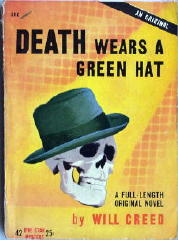
I do like the both the title and the cover of this one, and yes, a green hat figures prominently in the mystery, and I’ll get to it in a minute. Telling the story is a Manhattan-based advertising agency executive named Hal Boyd. Dead is his apartment mate and his best friend, Adrian Clay, a gossip columnist well-known around town.
Where things get interesting is that Boyd’s hat, a midnight-blue homburg is evidently a clue, because it is missing and nowhere to be found until it turns up mysteriously later in his bedroom, but green instead of blue!
Forgive the exclamation point, but that’s purely reflective of Will Creed’s style of writing. Pulp authors often wrote in the same vein, supplying artificial suspense or amazement when they couldn’t take the time (or weren’t able) to manufacture it on their own. I’ll have more to say about this later, and what it meant to me while I was reading the story, but at the moment, let’s reflect a little bit about hats, and what they mean in today’s world, as opposed to the mid-1940s… Who knows today the difference, say, between a fedora and a homburg? Derbies, OK, and panama hats, sure, but mention the names of any other styles, and you may as well be speaking Martian.
Inspector Day, whom Hal Boyd becomes friendly with (at least to a certain degree) and who allows Boyd to confer with him about large segments of his investigations — thinks hats are important too. Allow me to quote the inspector from his conversation with Boyd on page 34:
At last I spoke, and my tone was short. “Inspector, I may not know about crimes and how to solve them, but I do know that there ought to be some better way of finding a criminal than wishing for a hat.”
He looked at me sternly for a minute, his dark eyes questioning. “My dear Mr. Boyd,” came that soft easy voice, “it isn’t the hatness of the hat I’m wanting. It is anything out of place; anything the killer needed badly enough to risk calling it to my attention! It may mean nothing at all, your disappearing hat … but I cannot believe so. When a criminal keys himself to the point where he can do away with a human life, he knows that from that instant his own life lies in abject peril — that there is no choice once murder is done. It is a one-way street, Mr. Boyd. Therefore, anything that falls by the wayside, that disturbs the ordinary course of living, is important … to the murderer and to me. For instance, did the killer need your hat for something? It is far too labyrinthine to permit even the smallest piece of information to escape the eyes in this department, you see? That hat may mean nothing, but I dare not take chances. I am hunting a desperate person, Mr. Boyd, and I must be thorough indeed.”
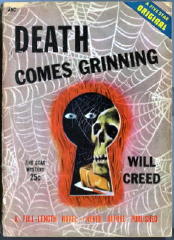
Boyd thinks of the inspector as rather an intelligent fuddy-duddy, but the inveterate mystery reader knows better. The hat is important, essential, crucial and/or all of the above. The mistake I made, reference above, is underestimating Will Creed as a mystery writer.
He may have had a pulpish, somewhat clumsy, gee-whiz style that lacks the push, the elan and/or the drive it needs to survive on its own, but he also had exactly the right instincts, Agatha Christie-like, to make the plot swivel and turn on a nickel and four pennies — or in other words, wow, I didn’t see that coming! — but without the knack of pulling it off with Christie’s ease and confidence that I really, really wish that Creed had had at his command.
Or maybe he did and I’m just yapping because he fooled the socks off me, no lie. I’m going to have to go back and read it again — and if that isn’t a sure sign of a magician at work, no matter what level of expertise, I sure as shinola don’t know what is.
BIBLIOGRAPHIC DATA. Expanded from the Revised Crime Fiction IV, by Allen J. Hubin:
CREED, WILL. Pseudonym of William Long, (1922- ); other pseudonym: Peter Yates.
Death Comes Grinning. Five Star #47, US, digest pb, 1946.
Death Wears a Green Hat. Five Star #42, US, digest pb, 1946.
YATES, PETER Pseudonym of William Long, (1922- ); other pseudonym: Will Creed.
Curtain Call for Murder. Vulcan #6, US, digest pb, 1945. SC: Thatcher family.
Death Comes to Dinner. Five Star #4, US, digest pb, 1945. SC: Thatcher family.
Death in the Hands of Talent. Five Star #7, US, digest pb, 1945. SC: Sandy Blunt.
The Dress Circle Murders. Five Star #1, digest pb, 1945. SC: Sandy Blunt.
[UPDATE] 07-23-08. I never did finish that article on Vulcan and Five Star Mysteries, although Victor Berch and I did manage to accumulate a lot of information and material toward doing so.
It took Ken Johnson to carry on independently and without me, and it’s his Vintage Digests website that you should be checking out, not mine. Follow the link in the line before, and scroll down to either Five Star or Vulcan.
He doesn’t include many cover images on his site, however. For those, you’ll have to go to the primary Bookscans website. For the Five Star, go here, and you can find some of the Vulcans here.
Tue 22 Jul 2008
A REVIEW BY MARY REED:
MELVIN L. SEVERY – The Darrow Enigma. Dodd Mead, US, hardcover, 1904. Grant Richards, UK, hardcover, 1904. Copp Clark, Canada, hardcover, 1904 (the cover of this edition is the one shown below).
The Darrow Enigma is narrated by an unnamed doctor, consulted by chemist and lawyer George Maitland for a bit of a nerve tonic. They become friends, for the narrator is greatly interested in science, and it is through this friendship that our anonymous physician becomes involved in the case.
Ultimately Maitland confesses the real reason he visited the medical man is because he is the Darrow family’s physician, and Maitland has fallen for Gwen, daughter of the house, and wishes to be introduced. Needless to say Gwen is beautiful even though, whisper it quietly, she does not imprison herself in corsetry.
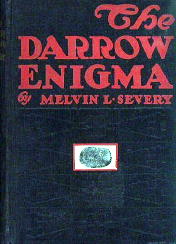
Well, then, an introduction to the young lady is effected and it is while the two friends are visiting the Darrow household and Gwen is appropriately singing “In The Gloaming” as dusk falls when her father John clutches his throat, cries out he has been murdered, and dies.
Yet there is nobody in the room other than the Darrows, Maitland and the doctor, and two other visitors. How then was it done?
The doors into the room were closed or locked, the only open window was perhaps six inches ajar and locked in that position and John Darrow was sitting in a high-backed chair over eight feet from it in any case, plus there were no niches or cupboards or curtains behind which the unseen assassin could hide.
Or was it suicide? Either way what was the weapon and where has it gone? To find out the police bring in three investigators: Mr. Osborne, Mr. Allen, and French-born Louis Godin, now reportedly the best detective in the U.S.
And so begins a tale with a dab of woo woo and a touch of gothic. John Darrow had had dreams foretelling he would be murdered, as a result of which Gwen makes him a certain promise that will later cause romantic havoc.
It is established there’s a connection to India long ago — though it is nothing to do with gems stolen from Indian temples — and Maitland steams off to pursue investigations there. After that he is off to San Francisco to find and interview a couple of Darrow’s former servants, who are Chinese and so, we might say, automatically suspect.
There follows a series of Strange Coincidences involving Anthony and Cleopatra, leading to what can only be described as a brilliant piece of deductive reasoning — involving reading detective novels! — that puts them on the track of certain parties of interest.
The culprit is brought to trial but is it the right person? Was the murder committed by the bizarre method the man on trial describes? What about the motive?
My verdict: First, the method employed is one that fits a clue hidden in the text, though I must say that more clues are needed so the reader can deduce the culprit. There are red herrings and side trips and everything seems to fit together very well until the final confrontation in the court room when the entire case is turned upside down.
Thus The Darrow Enigma is a bit of a mixture, though unlike the proverbial curate’s egg, on balance I would give it a nod rather than a frown since, despite the weakness mentioned, I found this novel enjoyable enough and the weapon utilised so outrageous and yet simple that points must be awarded on that alone!
In an aside, I was intrigued by Severy’s description of the eavesdropping device employed at an important point and consulted an electrical engineer about it. He said theoretically it was possible but the technology was not up to it at the time.
However, invention of this gizmo is not surprising as Severy held at least 90 patents. His fictional bugging device involves a piece of burnished silver fastened to a diaphragm, a small beam of light trained on the silver being reflected onto a sensitised moving tape photographically registering movement of the diaphragm for later conversion to an ordinary record.
Needless to say the result is a vital piece of evidence.
Etext: http://www.freeread.com.au/ebooks/c00040.txt
[BIBLIOGRAPHIC DATA] Taken from the Revised Crime Fiction IV, by Allen J. Hubin:
SEVERY, MELVIN L(inwood) (1863-?)
The Darrow Enigma (Dodd, 1904, hc) [George Maitland; Boston, MA] Richards, 1904.
-Fleur-de-Lis and other stories (Boston, MA: Esoteric, 1889, hc)
Maitland’s Master Mystery (Ball, 1912, hc) [George Maitland]
The Mystery of June 13 (Dodd, 1905, hc) [George Maitland] Stevens, 1905.
[UPDATE] 07-23-08. Here’s an email I received from Victor Berch this afternoon:
Steve:
On your blog, there was an entry for Melvin Linwood Severy taken from CFIV as 1863-?.
I’m assuming that by now Al may have his death date and other tidbits about him. But just in case,he was born in Melrose, MA Aug. 5, 1863 and died in CA on Oct. 12, 1951. He was an engineer, musician, an inventor and author. He was married to Elizabeth Ann Flint, born in Jackson, MO.
Most of this was verified on his passport application for travel abroad. Google has lots to say about him as an inventor. (Follow the link for one such page.)
Mon 21 Jul 2008

INTRODUCTION: Of all the various incarnations of
Mystery*File, this is one I’d have thought lost forever — if I’d remembered that it even existed, that is.
The issue is dated January 1987, and as far as I know now, there were only two copies made, the one I found this past weekend, and one I sent to Ellen Nehr, a well-known (and strongly opinionated) mystery fan who was also a good friend of mine. If you ever met her, I’m sure you’ve never forgotten her. Both copies were printed out using an Apple IIe computer and a dot matrix printer.
The issue consisted only of reviews I had written during a between-semesters break, with a short recap at the end. In a cover letter to Ellen, which I still have, I said I wasn’t looking for subscribers, nor was I going to join up with DAPA-Em again, so I don’t know what my intentions were. I assume I put the issue together for the fun of it.
At some point in time, I may have sent these reviews to George Easter, who’s still putting out his print magazine, Deadly Pleasures, but I’ll have to check the time frame involved to see if there’s any possibility of that.
The floppy disk I stored this issue on is long gone. Ellen died in 1995, alas, and I don’t suppose anyone happened to save the copy I’d sent her. So I assume my single dot matrix printout is the only way these reviews have existed these past eleven and a half years — until now, of course.
KARIN BERNE – False Impressions.
Popular Library; paperback original, November 1986.
From the copyright page – OK, so I’m a bit of a detective, too – aren’t we all? – it is easily deduced that “Karin Berne” is actually the Joint pseudonym of two other ladies: Sue Burnell and Michaela Karni. This is their third book; presumably the first two (Bare Acquaintances and Shock Value) also starred the “incomparable” Ellie Gordon as dedicated amateur detective.
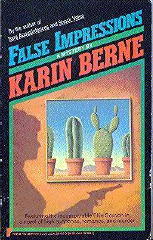
The “incomparable” was swiped from the front cover. If pressed, however, I guess I’d have to agree I haven’t an idea of whom I could compare Ms. Gordon to. (On the back cover Tony Hillerman suggests Kate Fansler, but I think Ellie is more down-to-earth than what I remember of the snobbishly academic Ms. Fansler. Or should that be academically snobbish?)
Ellie Gordon is divorced, but still young enough (apparently 39, but it is not altogether clear) to cause some of the chief male characters to look her way. And, no kidding, she does have charm. Or charms (usually, but not always concealed). Her previous two cases have given her a slight reputation as a detective, but not with the local Santa Fe police. (She’s visiting from California.)
In this particular case, a local art critic is murdered, at the opening of a gallery one of Ellie’s friends is the new co-owner of. Naturally, this leads to lots of suspects, as the art critic took his job seriously. And equally naturally, there’s more to the case than that.
This is a long book: 310 pages, to be exact. There is a lot of authentic-sounding New Mexican background to go with the mystery, plus a couple of near-fatal accidents – the second involving the rapid descent of a hot-air balloon — and occasionally one wishes for the story to pick up just a little. Still, the clues are nicely placed, and the plot thickens just in time for a rousing conclusion.
In retrospect, one can easily identify the killer at a pair of crucial junctures. One was intended, and the other probably not — but of course I can’t tell you about either one, can I?
— January 1987.
[UPDATE] 07-21-08. As it so happened, this was indeed the third adventure of Ellie Gordon, and it was also her last. Nor did either co-author write another mystery under this or any other name, including their own. All three were paperback originals from Popular Library between 1985 and 1986.
Note in passing that I called a 310 page mystery novel “long.” Times have changed since then, haven’t they?
And, oh, one last thing. It has just occurred to me to check the Amazon sales ranking for False Impressions. As of five minutes ago, it was the 2,989,979th most popular book, which means that it’s not totally forgotten. Some sales rankings are in the 6 million range, so in a sense, it’s holding its own.
Mon 21 Jul 2008
THE SECRET WAYS. Universal Pictures, 1961. Richard Widmark, Sonja Ziemann, Charles Régnier, Walter Rilla, Senta Berger, Stefan Schnabel, Hubert von Meyerinck. Based on the novel The Last Frontier by Alastair MacLean (published in the US as The Secret Ways). Screenwriter: Jean Hazlewood (Mrs. Richard Widmark). Producer: Richard Widmark. Director: Phil Karlson.
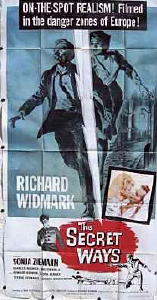
One note about the credits before I begin the review itself. Unhappy with the way things were going, Widmark is said to have fired Karlson and directed the last few weeks of filming himself. In one sense this may have been a good idea, since Karlson later directed Dean Martin in two of the Matt Helm movies. It was his idea to go in that direction even earlier with The Secret Ways, but apparently Widmark put his foot down and said no.
On the other hand, whichever hand was at the helm, this is not a very good movie, and in some ways it is downright bad. I have not read Alastair MacLean’s novel, but it had to have been better than the filmed version of it. If not, I submit to you that the novel would never have been published – and therefore no movie, and this review is about to disappear itself.
It isn’t the acting – top notches should be awarded to everyone involved all the way around, starting with Widmark himself as Michael Reynolds, who’s neither a spy nor an espionage agent, but only a slightly disreputable gent forced by gambling debts to take on a task by Swiss banker Hermann Sheffler (von Meyerinck). The job? Only to rescue a charismatic political figure named Jansci (Walter Rilla) from behind the Iron Curtain.
Posing as a journalist, Reynolds’ only lead is Jancsi’s daughter Julia (Sonja Ziemann) who has recently survived an escape attempt herself. One of the sources Reynolds uses to find Julia, by the way, is Elsa (Santa Berger), the latter an actress who proves that beautiful women can also act, Hollywood preconceptions to the contrary, which explains why most of her films were not made in this country.
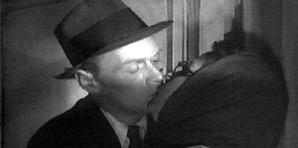
The only problem is, Julia wants to go with Reynolds back into Hungary, and Jansci himself does not want to leave. (It takes a lot of effort to reach him and eventually convince him.)
The acting, as I said, is of high caliber, the outdoor shots (Vienna, I believe) are as authentic as they could be, and so what goes wrong? The story. Individual scenes are perfectly done. They just don’t combine together in any coherent way you can think of. Things happen, you (the viewer) wait for an explanation, and the explanation never comes.
Reynolds get beaten up early on – so, OK, his cover is blown. He’s rescued by Elsa – and if you are male, how would you like to wake up in the morning being nuzzled by Santa Berger after being rescued by her the evening before? But why? To what purpose? Why does she have the address for Julia that he needs? Why does she give it to him? How did she happen to meet him earlier in the restaurant in the first place?

Yeah, I know. Motivations are murky in all the good spy movies, but if MacLean’s novel was the basis for this movie, you get the idea that it far too complicated for them, and they stripped away all of the non-essentials and simply went with what was left.
Later on, Reynolds and Jansci have been caught, drugged, beaten up by the Communist authorities, and in as sad shape as they’re in, they … Or, as they say in the vernacular, aw, come on.
I see that I haven’t mentioned Sonja Ziemann. Slim and brunette, and her character naturally attracted to Reynolds in spite of a bad start between them, she’s quite a beauty, with a long career in the German film industry, which explains why I hadn’t heard of her before. Perhaps you have.
I’ll close by adding some screen shots here at the end. I may have gotten into the bad habit of trying to squeeze too many of them into the reviews themselves, but in this case, they’re too good to not use them at all.
(1) Reynolds being guided by Elsa to her apartment after getting beaten up:
(2) Reynolds with Julia as they begin to realize what they are up against:
(3) Reynolds and Jansci in their interrogation room:
(4) On their way to the airport and safety!
Sun 20 Jul 2008
Posted by Steve under
Authors ,
ReviewsNo Comments
JoANNA CARL – The Chocolate Cat Caper.
Signet paperback original; 1st printing, March 2002.
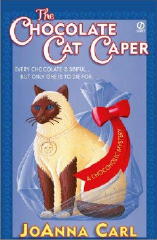
It’s not clear to me how many murder mysteries can take place in one small town in Michigan, but that’s the only possible drawback I can see to a long successful run to this new series, just started. All of the ingredients are there: an blonde ex-trophy wife trying to restart her life, an aunt who owns a chocolate shop in a resort town along the Lake Michigan shore, assorted townspeople of various ages, character and temperament, and of course I mentioned chocolate, didn’t I?
According to the copyright page, the author is better known as Eve K. Sandstrom, who earlier wrote the Sam & Nicky Titus series, all of which took place (if I’m not mistaken) in Oklahoma, and more recently, another series of paperback originals featuring a newspaper reporter named Nell Matthews and her boyfriend, cop Mike Svenson.
In this book, after only a couple of days back in Warner Pier, Lee McKinney watches as an unliked (unlikable) criminal defense attorney falls to her death before a party at her home begins. The lady did not die of the fall, however — someone poisoned the platter of chocolate cats Lee’s Aunt Nettie furnished for the affair.
Smoothly written and adeptly plotted, the book is a pleasure to read, with just enough suspects to make the mystery interesting, if not challenging. There’s a hint of romance by book’s end as well, not unexpectedly. Those of you who are primarily hard-boiled private eye fans will find the nourishment here mighty thin, but enthusiasts for cozies (you know who you are) will eat this one right up.
[UPDATE] 07-20-08. I’ll pat myself on the back for this one, since I’m going to say that I was right. The series has been a big success. Cozy mysteries have certainly continued to be popular since I wrote this review, but it never hurts to have a solid detective story at the core, which if I’m reading my own review correctly, this one has.
There have been eight novels in the series in seven years, not a shabby track record at all, not by anybody’s standards. All of the books below are Signet paperback originals, I believe, except for the forthcoming #8, which will be the first in hardcover. (Any earlier hardcovers are book club editions which came out after the paperbacks, but if I’m wrong about that, please let me know.)
The Chocolate Cat Caper. March 2002.
The Chocolate Bear Burglary. November 2002.
The Chocolate Frog Frame-Up. December 2003.
The Chocolate Puppy Puzzle. December 2004.
The Chocolate Mouse Trap. September 2005.
The Chocolate Bridal Bash. August 2006.
The Chocolate Jewel Case. August 2007.
The Chocolate Snowman Murders. New American Library, hardcover, September 2008.
Next Page »





